Okay, I know the title is a little harsh, but I really mean it. When I bought my first black powder revolver it was a Pietta 1861 Navy and I was pretty underwhelmed. However, if you’re new to black powder revolvers, I still highly recommend that you start with a Pietta!
If you’re looking to purchase your first cap and ball revolver, or maybe just your first Pietta, then this review is intended to not sugar coat what you might be receiving.
I’m not sponsored by Pietta or affiliated with them in any manner, and I’m just calling it how I’m seeing it based on my own experience. My criticisms might seem harsh, but I do have some praise for Pietta by the end. You can open this article that I’ve written (it will open in a new tab) on my experiences with Uberti as well, and I have a head-to-head article where I do a quick breakdown of the main differences and similarities between the two here.
But in this review of a Pietta cap and ball revolver I’m going to go over my negative experience with my Pietta but why I’m happy I bought it — and why you should buy one too!
⬇⬇⬇ I’ve got a video below as well if you want to check it out as well 🙂 ⬇⬇⬇
Pietta Has Weak Internal Springs
This might seem like a strange complaint to make first, but it’s really what soured my opinion of my Pietta purchase in the first 2 minutes of holding it after it arrived.
Like Ralphie from A Christmas Story, I couldn’t wait to run outside and grab my delivery from Dixie Gun Works when the mail came. I was so excited as I tore through the packing paper and carefully opened my first black powder revolver.
It was in a bag with a cosmoline type substance and I carefully wiped the exterior down and just held it.
The first thing I noticed is how heavy it was when compared to my modern, every day carry piece.
I pulled the hammer back and counted the clicks. One, two, three. I remember reading that Colts have four clicks (not sure if that applied to their cap and ball revolvers), but I won’t judge this since it’s a replica.
I gently let the hammer down. I proceeded to pull the hammer back and let it down about a dozen times and then…
Absolutely nothing.
The firearm ceased to function.
The cylinder was now spinning freely, wouldn’t lock up, and the hammer was not working right.
To say I was upset was an understatement.
Since this was during the global events of 2020, there was actually a run on cap and ball revolvers and components and I believe that situation still exists now in 2022. I wasn’t going to send it back and wait for a replacement for months (or longer) since they were already out of stock by the time mine arrived.
Instead, I had to custom order replacement springs and wait another 4 weeks for them to arrive and to be able to use the firearm again.
That moment would set me on a path that would begin with disappointment and end with a passion for the hobby and a pretty thorough understanding of the mechanics and gunsmithing that needs to be done to get one of these replicas to function properly.
What happened with the revolver, you might be wondering?
There is a forked spring on the inside that controls the trigger and the bolt (the piece that locks the cylider in place). That just snapped in half simply by cycling it a few times. No abuse. No fanning the hammer. Just cheap and soft materials. There are better replacement springs, and we’ll get to that later.
Fit and Finish
The overall fit and finish of my first Pietta was nothing to be impressed by.
The wood selection for the handles was just average to acceptable. I guess I wasn’t expecting anything fancy anyway so they definitely delivered to my low expectations. The grain is walnut stained and pretty monotone throughout.
Nothing in the grain stands out to give it character or any color variation to show depth.
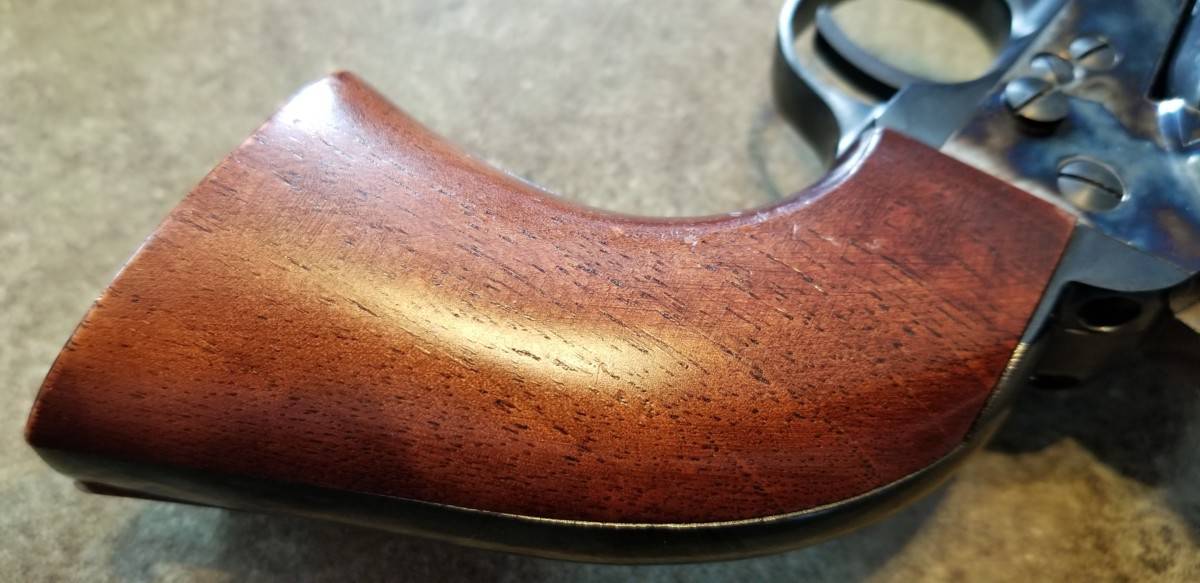
The top finish of the wooden handles was satin at best. Not shiny, just kind of drab.
Aesthetically, they’re just plain but acceptable.
Now, how the wooden grip fit to the frame and metal strap is another issue altogether.
This handle was 90% fit to the gun itself. It jutted out in the back to where anything that hit the wood would certainly chip it away since it was standing proud of the metal strap — by a lot.
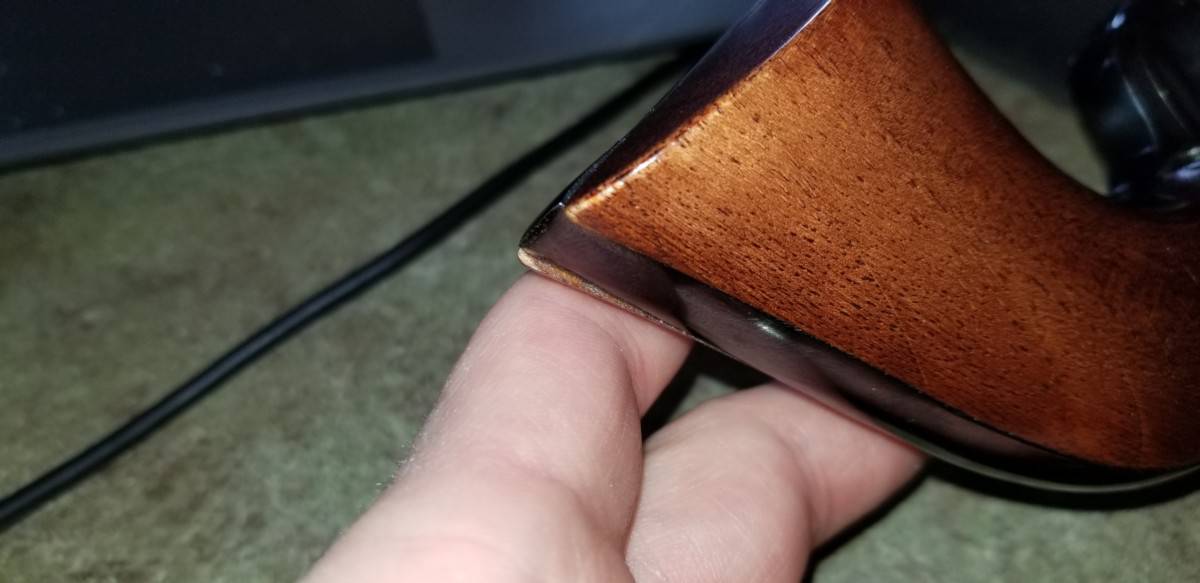
I could see daylight between the handle and the frame itself.
If you’ve ever held a Rough Rider .22LR revolver, then you get what I’m saying. Functional? Yes. Crude? Yes.
This has led me on a quest to get the grip to fit properly, and after several attempts at bending the strap ever so slightly, I’m pretty content with just letting it be my ugly Pietta. Maybe I’ll fix it someday, but I’ve got other things to do.
The color case hardening finish looks great, so I’ll give it points there. If you’re new to these firearms, it’s just a finish that can easily be removed with a file during any gunsmithing that you might have to do — so tape things off and be careful!
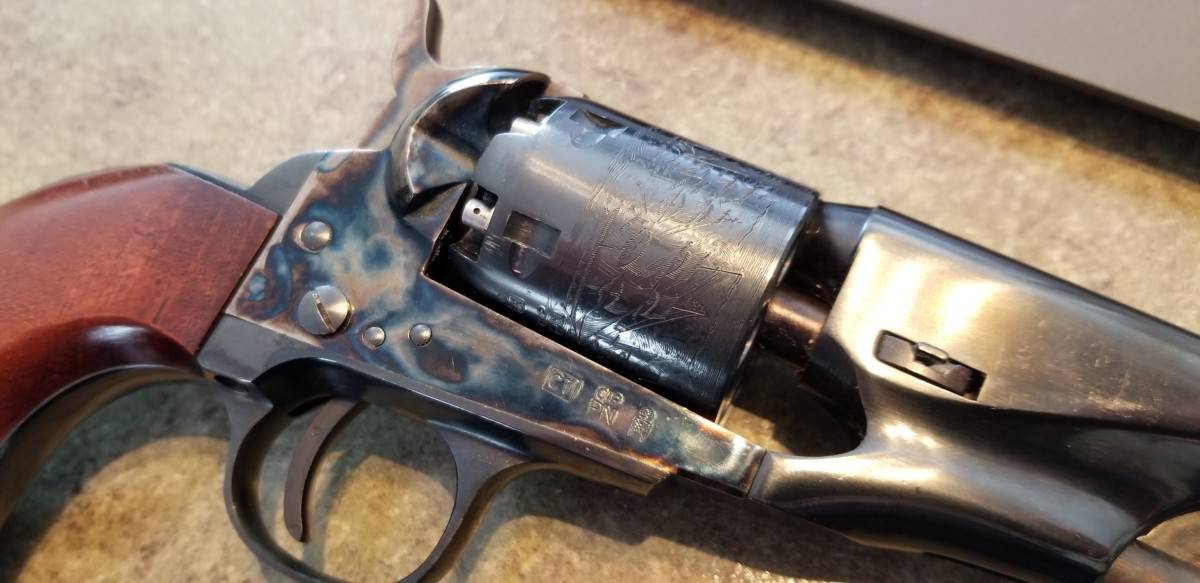
The etching on the cylinder that depicts the naval battle scene is no different from any other brand and looks great.
The screws strip very easily! Be sure to invest in some gunsmithing screwdriver bits and be gentle. One slip and you’ll gnarl the head of the screw you’re working on. They are NOT forgiving!
Bluing is totally fine with no other blemishes or scratches to note.
The Print on the Barrel
If you’ve done any research on cap and ball revolvers, you have inevitably seen that Piettas love to defile their barrel with what the firearm is, what brand it is, and where it was made.
It’s cheap and reminiscent of the cap guns I used to play with back in the 80’s and early 90’s.
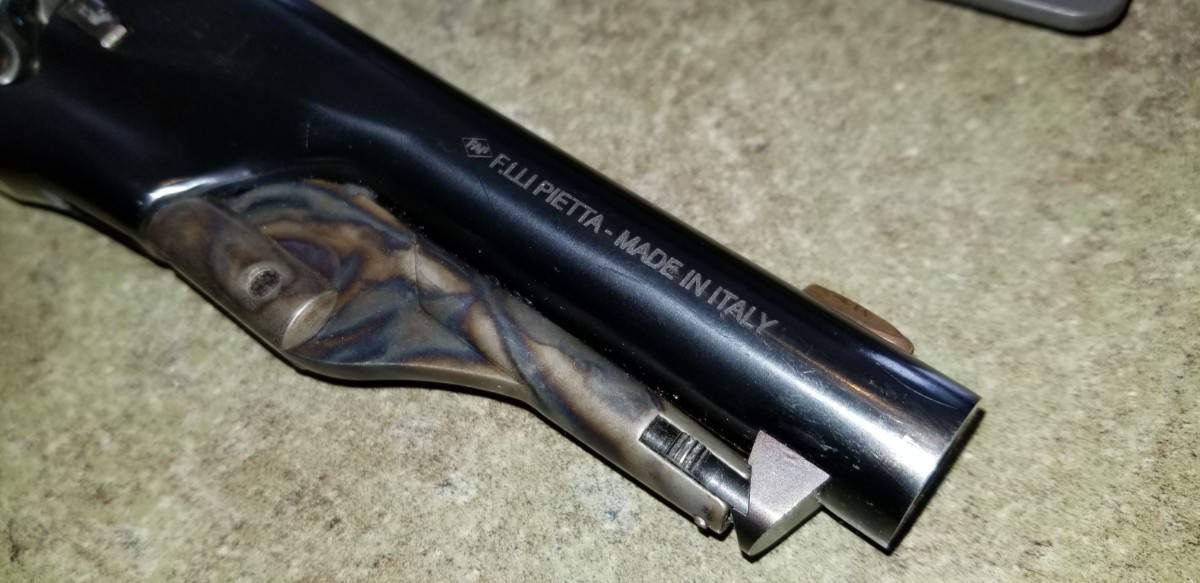
I get it — these are replicas. Yes, they’re replicas — but they’re still not toys.
Pietta, if you’re listening — hide your print beneath the barrel like your primary competitor!!!
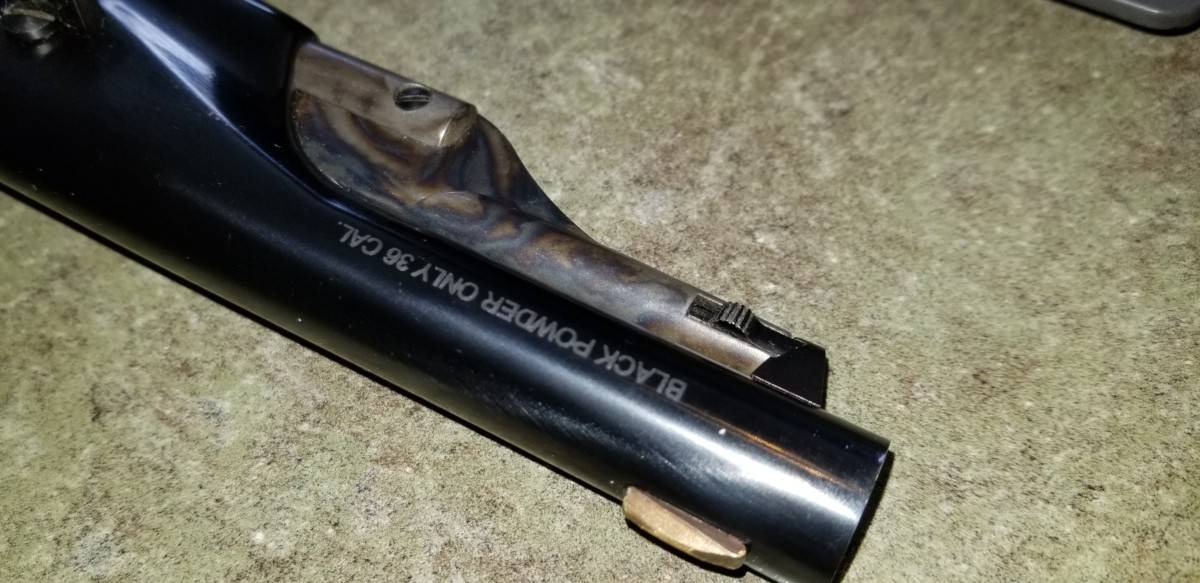
My number one reason for not purchasing more Piettas comes down to this very reason. I want something I can put on display and not have it look like a cheap toy from China. Yes, it shoots great, and I’ll get to that, but when the shooting is done and the gun is cleaned, I want it to sit proudly in a display case as a conversation piece.
Instead, my Pietta sits in the safe and is simply my “beater gun”.
The Hammer (top and hammer spring)
When you get a Pietta you won’t really know that you don’t like the hammer until you have seen a hammer from their primary competitor, Uberti.
Now that I’ve held both, I dislike my Pietta even more.
As you can see from the picture below, the hammer on a Pietta is simply shallow grooves in a linear pattern for your thumb to grip onto when pulling it back.
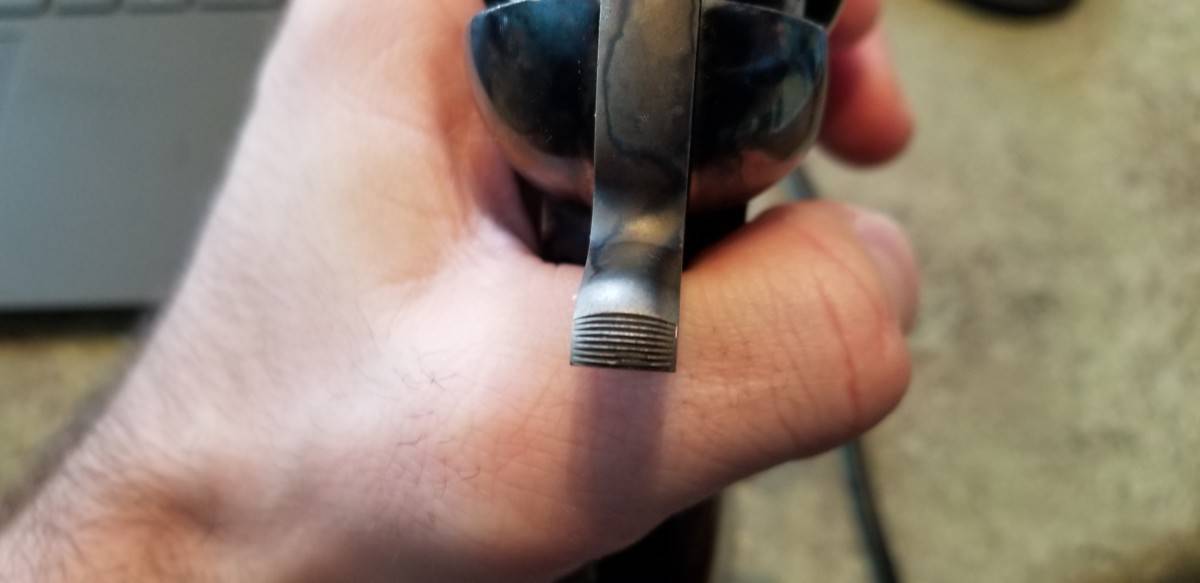
It actually barely grips your skin on your thumb at all and I can see this leading to my thumb slipping off it prematurely when trying to draw it back.
If you want to see what their competitor is doing with their hammers, my article here will show you the difference.
The hand spring that rides along the hammer was another area of frustration. About once every 20 hammer pulls the hammer would stop pulling after about 1/4″ from its resting position. I’d let the hammer back down and then it would work for another 20 pulls or so.
Definitely not something you want if you’re going to ever rely on this to save your life.
I tried filing out different slots and slicking up things the best I could but the problem persisted.
I found out that the hand and the spring that’s attached to it were not properly bonded together. The spring could wriggle side to side with ease.
About once every 20 shots or so, something would move out of alignment and bind the hammer up.
I simply melded a little solder where they meet together and filed it flush. No more slop in the spring/hand, and I haven’t had a problem since.
Once again, cheap springs.
Accuracy
I am not claiming to be a gunslinger or even a great shot. I’m competent with the firearms I’ve used and everything I’ve done with them has been “good enough” to get the job done.
I’ve shot the Pietta out to 20 yards and it performs as expected.
I have had zero flyers and they all stay in a paper plate at that distance when shooting with one hand. The closer I get, the better the group.
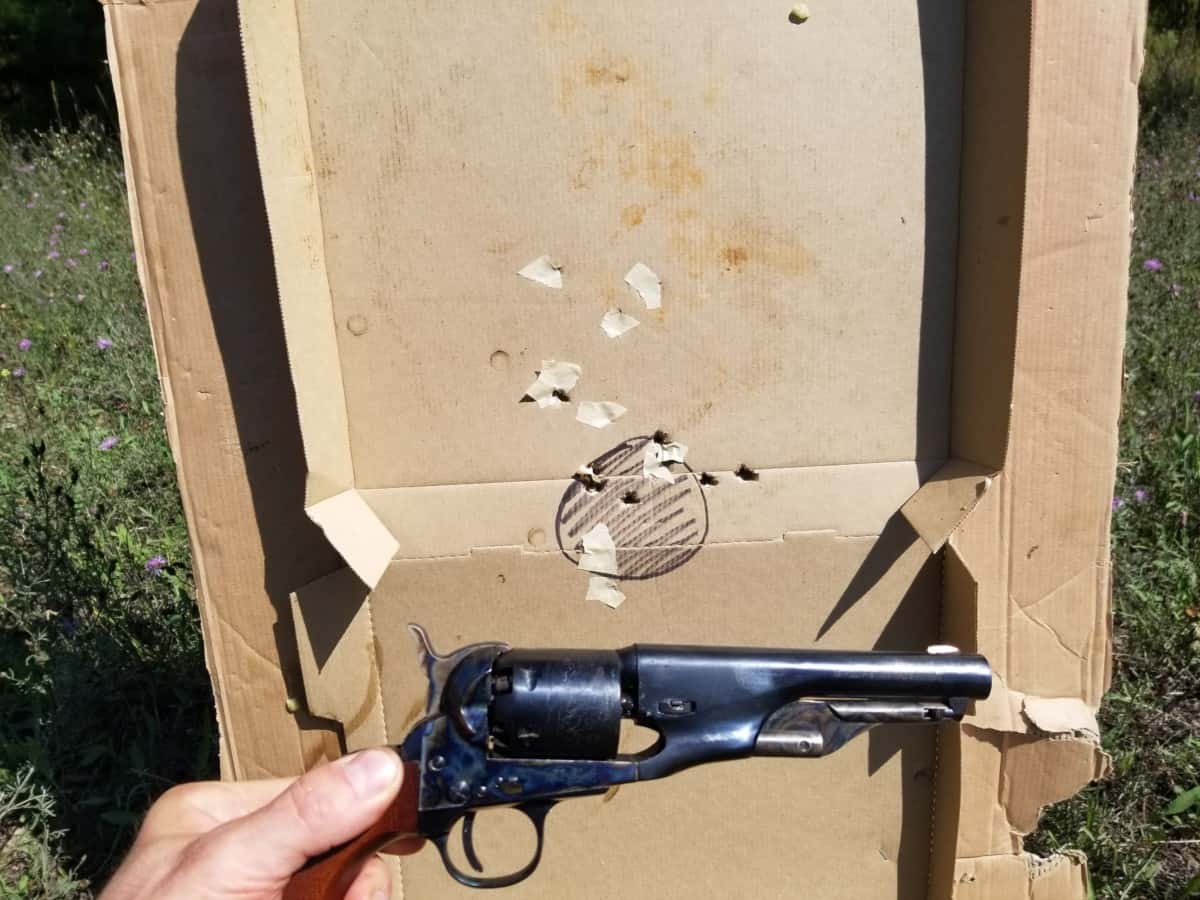
I recommend making a mental note of what chambers on the cylinders are what before you start shooting, and check your target after each shot and take note of where it lands. It is possible to have a single bad chamber that will always shoot wild. Make that the one you keep unloaded if you cowboy carry.
I’m sure there’s an art to shooting single action black powder revolvers. I haven’t been taught anything as far as the proper grip or anything, but I haven’t had any negative experiences with making contact with the target.
Keep in mind that a Pietta, or any other replica, will shoot high. That’s what they were designed to do back during the civil war and I believe their “zero” was about 70 yards or so.
If you don’t want to do any filing, make sure to aim anywhere from 4-8 inches low when shooting at distances of 10-20 yards.
“Aim for the belt buckle” to hit the heart was good advice back in the day.
Reliability
I watched Duelist1958 a lot before I first used my revolver and made sure to “slick up” the action the way that he does before I ever fired a shot.
I also replaced all of the factory cones (or nipples) with SliXshot stainless steel cones and replaced the trigger/bolt spring with one from Wolff Gun Springs. Choose EMF if you click on the link and need Pietta springs (NOT affiliate for either link).
Having done all of this, I have experienced only a single cap jam in over 150 rounds that I’ve put down range.
I use 18 grains of FFFg powder and a 0.380″ lead round ball with Remington #10 caps.
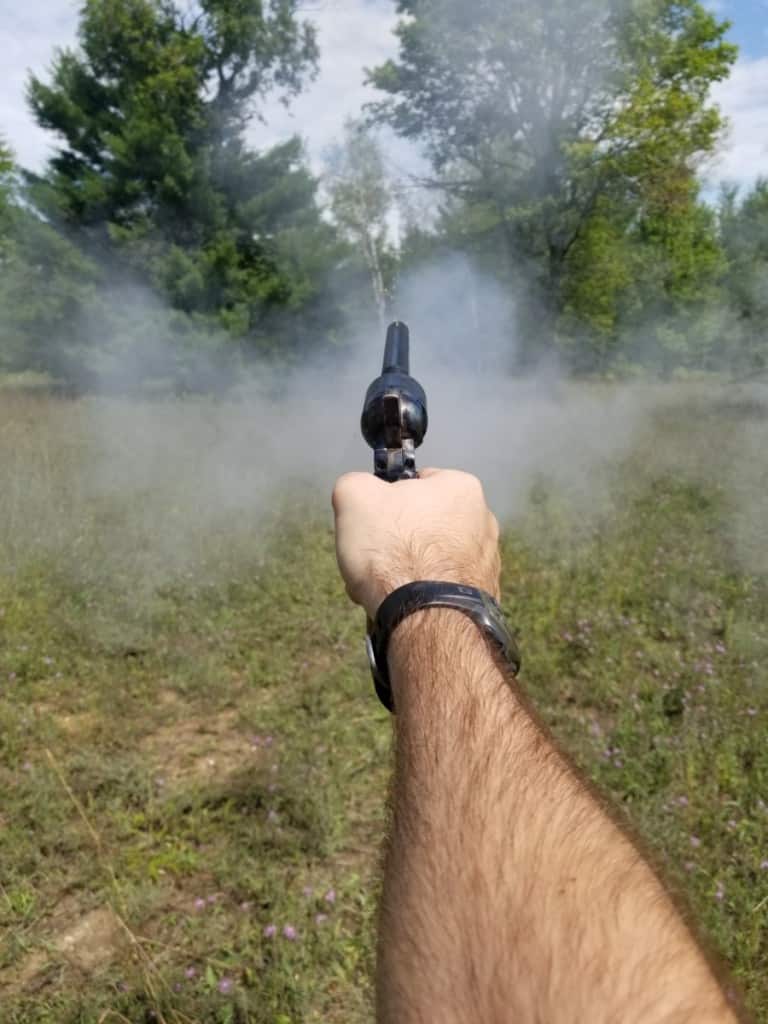
To dial in how much powder you should be using so that you’re not wasting it, I recommend shooting about 10′ from your target and placing some opened and empty pizza boxes on the ground beneath your target.
If you’re using too much powder, you’ll see unburnt powder grains covering the pizza boxes. I was using the sherriff’s model with a shortened barrel, so the 23 grains of powder I started with could not fully combust before the round ball exited the muzzle. I found that 18 grains seemed to combust fully enough so that I was not wasting powder unnecessarily (try buying some right now, if you can find it).
Crown
Pietta does NOT take the time to grown the muzzle of their firearms (or at least the black powder models that I’ve seen and held). The barrel is simply cut at a 90 degree and that’s the end of the story.
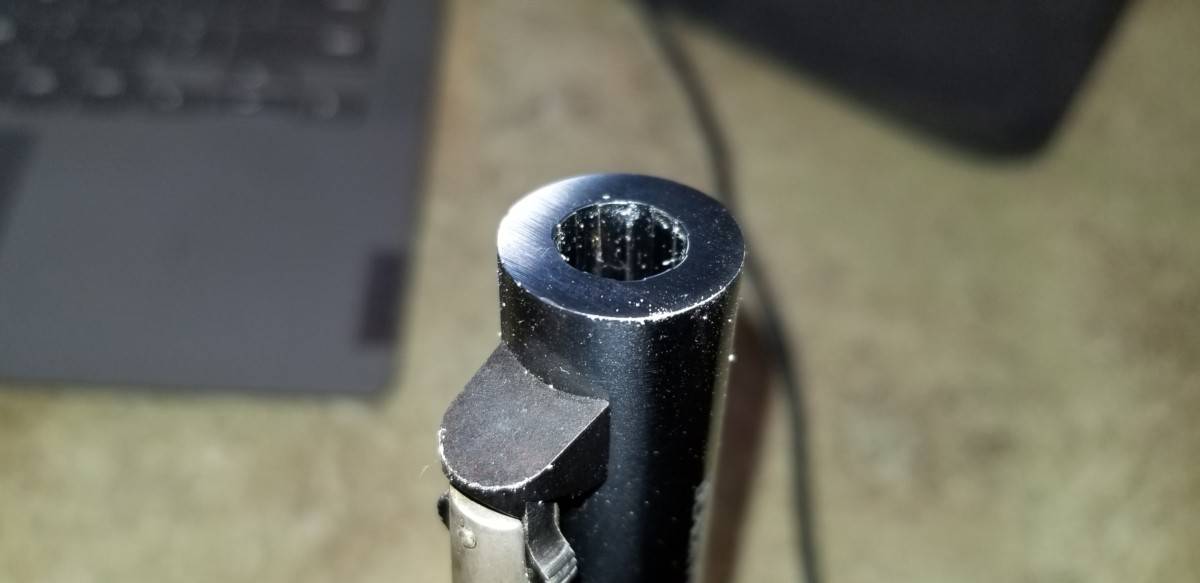
If you do happen to drop your Pietta, or if the muzzle hits anything with enough force, then there is a higher likelihood that you will damage the edge of the muzzle which can certainly affect accuracy.
How much will it affect things at 15 yards? Probably not enough to be noticeable, but it’s still something to keep in mind about the cost cutting measures that Pietta takes.
You can check out my article here on Ubertis to see how they crown their barrels.
Why Pietta Makes a Great First Cap and Ball Revolver
Now that my rants are over, I’m going to sing some of the praises that are due.
Yes, it’s a pretty ugly gun when compared to the Uberti’s that I’ve had a the pleasure of handling and owning, but Pietta is a functional workhorse right out of the box…. well, if we can get past the broken trigger/bolt spring.
Why do I like Pietta over Uberti when it comes to your first black powder revolver?
- Cost
- Minimal Post-Purchase Gunsmithing
- Cylinder Gap is Perfect
- Reliability (with the right aftermarket parts)
At the time this article was written (early 2022), the cost of a Pietta is generally about $315 to $450 depending on the model you select, and the prices have risen about 15% over the last 2 years due to supply and demand due to the global disruptions, I’m sure.
Still, at those prices, they are far less expensive as their primary competitors. The range for Uberti models will span from $375 to $490 and have also increased 15% in the last 2 years.
*The prices noted above are January 2022 prices from dixiegunworks.com and do not include shipping and tax, which will increase the costs significantly.
So, if you’re on the fence about black powder revolvers and just want to dip your toes in to the hobby, a Pietta makes a fantastic choice with the lower price point.
The lack of post-purchase gunsmithing is also a HUGE selling point to anyone who really just wants a functional gun out of the box without having to do a lot of filing and adjustments to get it to function properly — yes, I’m looking at you Uberti!
Sure, I had to replace a spring right out of the box with the Pietta, but once I installed the new Wolff Gun Spring and soldered the hand spring, this gun has been very reliable and the fixes for the springs were minimal in nature and not technical issues that require professional help.
Maybe I got a lemon, and most Piettas have decent springs out of the box. If that were the case, then this gun would have been range worthy from the beginning without any deeper functional problems. I CANNOT say the same about all of my Uberti purchases which required lots of gunsmithing and troubleshooting. If you want the low down on my issues with Uberti, feel free to read those here.
The cylinder gap is great on any Pietta I’ve ever held and they come that way from the factory. While Pietta may not know how to hide the writing on their barrels, they have figured out how to properly fit the barrel assembly to the frame of the gun so that the gap between the cylinder and the forcing cone of the barrel is all but nonexistent. This means you won’t have a drastic loss of velocity as burning powder goes screaming out of a gap between the barrel and the cylinder.
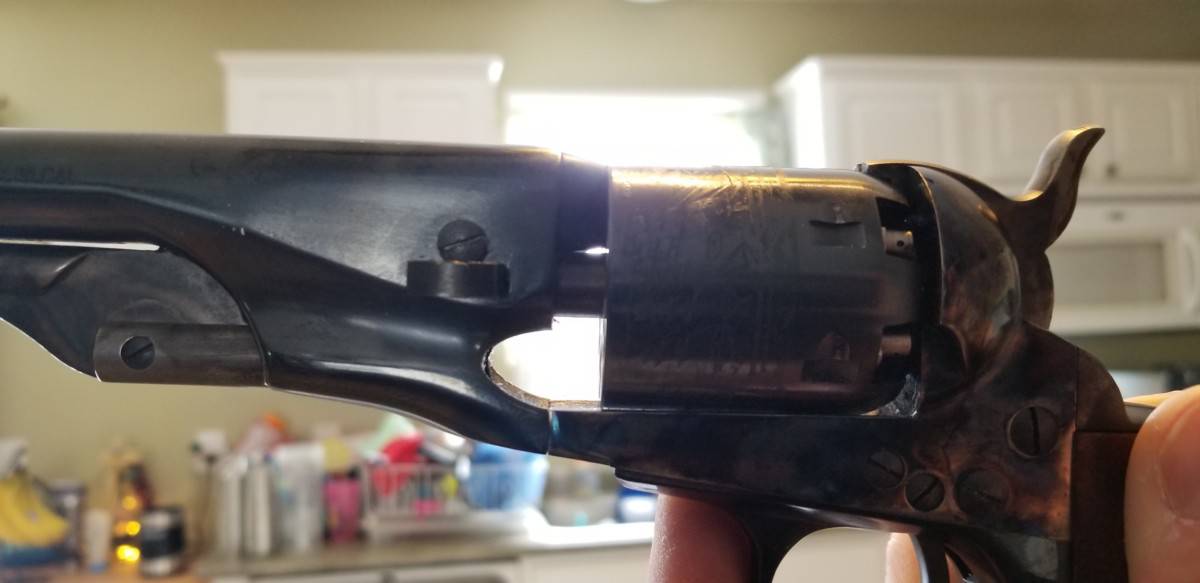
You will NOT see daylight between the cylinder and the forcing cone of a Pietta! I can’t say the same about their competitor.
Finally, like I said before, despite its initial flaws and aesthetics, the Pietta turns into a solid and reliable workhorse once you replace or repair the two aforementioned springs inside.
Pro Tip: If you decide to buy a Pietta, I highly recommend simultaneously ordering a corresponding trigger/bolt spring from Wolff Gun Springs, aftermarket SliXshot cones, and you’ll likely need to replace the screw that holds the trigger bolt spring with a slightly longer one from your local hardware store since the Wolff springs are a little thicker and the factory spring can’t reach far enough to thread itself.
I have only experience a single cap jam with the Pietta and I have shot over 150 rounds through it (using aftermarket cones and having slicked up the action).
Overall, the Pietta was about 85% of its full potential right out of the box. A solid “B” grade.
ALL blackpowder revolvers will have issues right out of the box, and if you haven’t found one with yours then you’re either really lucky or you’re not looking hard enough.
For a person looking to have a gun that’s as close to “range ready” without doing much in the way of gunsmithing, then I HIGHLY recommend purchasing a Pietta as your first revolver.
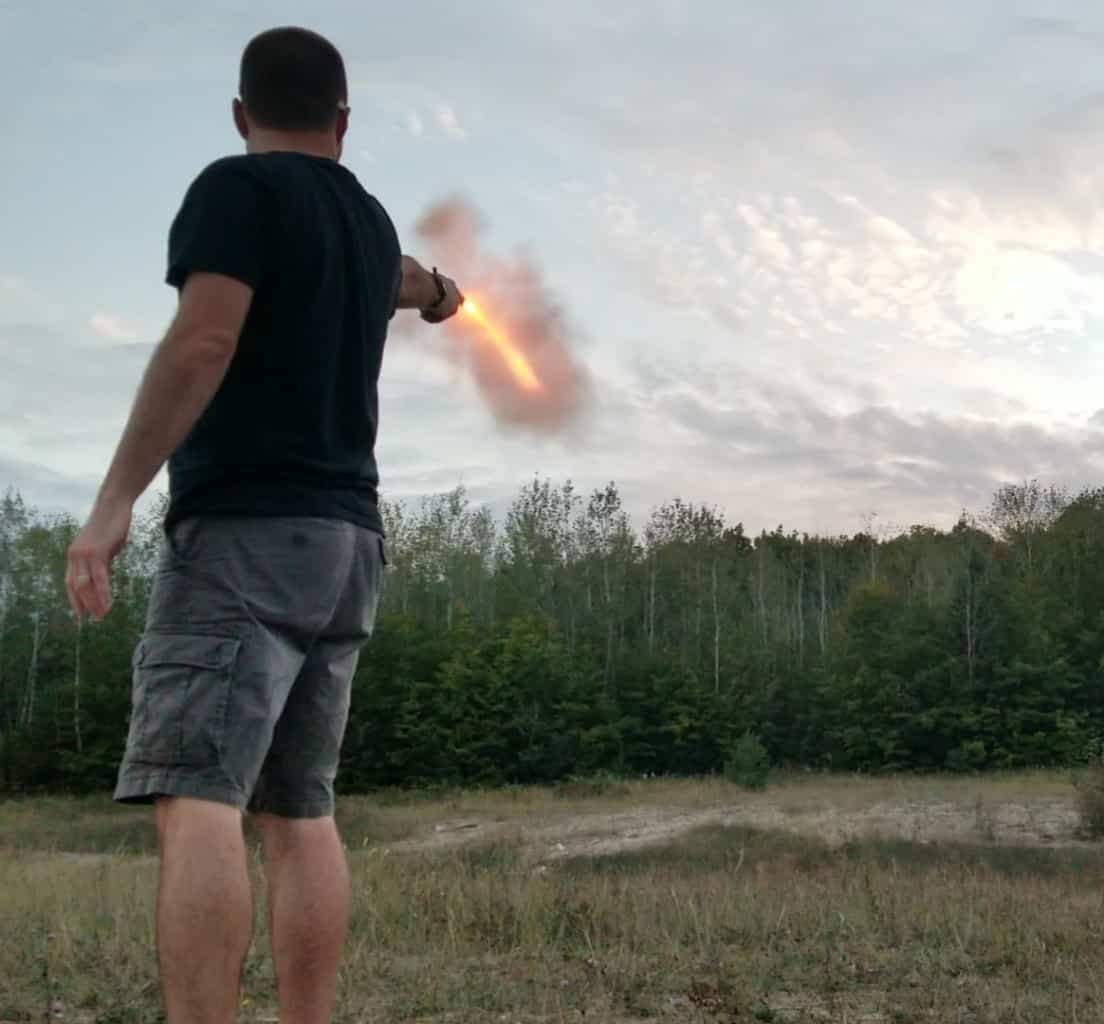
Being that it’s not a “looker” and probably won’t ever occupy a display purpose, you also won’t feel as bad if you find you like the hobby and want to experiment with getting your 85% revolver as close to 100% as possible.
My Pietta taught me all about the mechanics of these firearms because I wasn’t paralyzed with fear of ruining it. It was an inexpensive gun when I bought it on sale 2 years ago. I will forever be grateful for all the lessons I learned from it. When I bought Ubertis afterward and had tons of issues with them, I already knew how to fix them from all the tinkering I did with my Pietta.
My Pietta is my workhorse and my field gun. I don’t worry about getting any scratches or dings on it, and if it started to rust a little bit because I missed a spot with cleaning I wouldn’t be upset. I love shooting my Ubertis, but I also love how they look on display. My Pietta though isn’t cut out for the display case — she just wants to get outside and have some fun.
